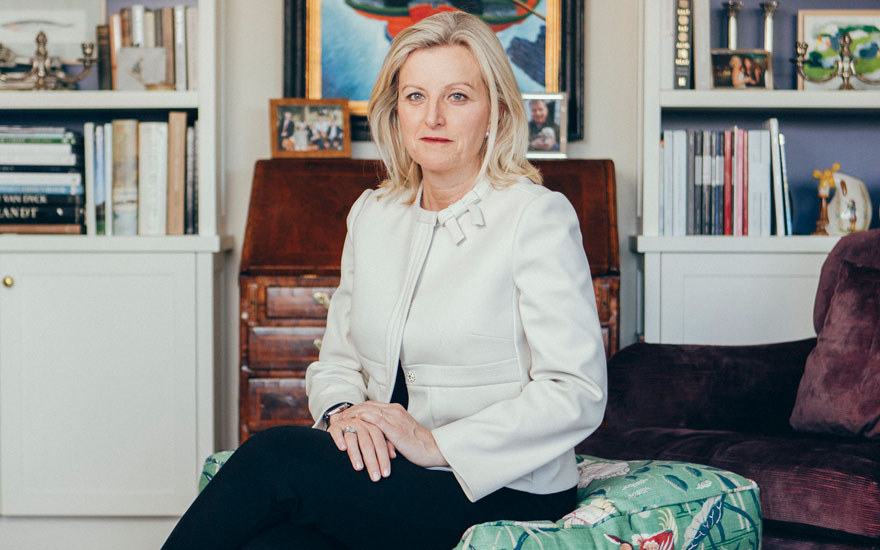What I’ve learned: Tash Perrin
Our New York auctioneer on selling David Gilmour’s guitars, the power of silence, and her personalised collection of gavels
I arrived at Christie’s thinking I was going to be a specialist, but six months into the job I realised I wanted to be the person on the rostrum. A lot of auctioneers have nerves of steel and confidence in abundance — but that is not me. What appealed was the art of the transaction, the place of the auctioneer in the larger scheme of things.
At high school I had to choose between art and music; I chose music. I can’t draw a thing, that’s just not in my wheelhouse, and I didn’t know anything about art. But when I graduated I did a bike tour of Europe. Our guide would take us to a museum in each city and show us just three things, no more — maybe a Rembrandt, a Dürer, a Bosch — then we would leave. Something about that ignited a passion in me; it was like a lightbulb going on. When I got to university I started taking art history classes.
My first lot was one of my scariest — partly because I had to be introduced to the room: ‘And now, here is Tash Perrin, making her debut in auctioneering!’ That made me cringe, but my whole department came down to watch and support. Even Gil Perez, our doorman in New York, was there rooting for me. That was amazing.
I didn’t even consider whether auctioneering was a male or a female thing. When you look back at James Christie, the firm’s founder, what you see is an erudite, dapper connoisseur-about-town. He had academic knowledge, and charm enough to persuade Thomas Chippendale to make him a rostrum. None of that had anything to do with his gender. My father always says: success happens when preparation meets opportunity.
‘The goal is to be yourself. Every auctioneer has to find a personal style, a rhythm and groove of their own, because nothing else works’
For every sale there is an Auctioneer’s Book — and it is our most important tool. The Book tells me who consigned each lot, the estimate, the reserve (we were trained to use code for this: ‘DX XXX’ means $10,000). It notes absentee bidders and their paddle numbers, so you know that, say, 1726 is willing to spend up to $175,000. During the sale you have to be able to look quickly down at the Book, take a mental snapshot of all the facts and figures, then look up and address the room.
The best auctioneers all use silence. It is a way of holding the energy in the room. As you get to the climax of the bidding process, it’s important to mark that pregnant pause before the hammer goes down. Sometimes, in that instant, I look at a bidder. They might use the moment to say: OK, you are right, I do want to come back in. Or you might see them think: I am out, but thank you for not rushing me.
I help train our new auctioneers. Often trainees admire a particular auctioneer, and so they try to emulate or mimic that person. But as with many things, the real goal is to be yourself. Every auctioneer has to find a personal style, a rhythm and groove of their own, because nothing else works. The last thing I would want is for all our auctioneers to do it the same way.
David Gilmour’s guitars were a memorable experience for me. That was the first auction my husband came to — he’s a huge Pink Floyd fan. Our bid department, meanwhile, is made up entirely of young women who didn’t recognise the name David Gilmour. They were asking: who are the clients? What do they look like? So I got my husband and said: take note, they mostly look like him. I had to figure out what to wear at the rostrum on the night — a grey pinstripe didn’t seem right. So I wore a Floyd concert T-shirt under a pink blazer.
Sign up today
Christie’s Online Magazine delivers our best features, videos, and auction news to your inbox every week
Subscribe
I enjoyed learning new facts for that sale. You have to sound authoritative, to be able to say, ‘Now we have the Red Strat, played at Live Aid, Wembley Stadium, in 1985’ rather than just read out the catalogue entry: ‘A Solid Body Electric Guitar, Stratocaster, 57V’. In the Book there was a handwritten annotation that mentioned Roger Waters — only I misread it as ‘Roger Walters’. When I read that out, the room exploded with laughter. I looked over to my husband and could see him mouthing, ‘Nooooo!’
I collect gavels; I don’t know of an auctioneer who doesn’t. There is a carver in England who makes them for Christie’s. We present each new auctioneer with a gavel when they get their licence. You never hold a gavel by the handle and whack it down like a hammer. You grip it by the head. The handle is just there to make sure it doesn’t roll off the rostrum. I have a special gavel with my initials on it. It travels with me, and I can’t imagine taking a sale without it.
8 September 2020
Pop Culture & Collectibles | Meet our specialists
Main image:
‘It’s important to mark that pregnant pause before the hammer goes down’: Tash Perrin. Photograph by Brendan Burden. Artwork: John Neville
AddThis Sharing Buttons
Share to FacebookFacebookShare to TwitterTwitterShare to PinterestPinterestShare to WeChatWeChatShare to PrintPrint
Get the best stories from Christies.com in a weekly email
Sign up now
*We will never sell or rent your information. Privacy Policy
Related feature
[
The David Gilmour Guitar Collection sells for $21.5 million
Read more
](https://www.christies.com/features/David-Gilmour-Collection-auction-results-9974-3.aspx?sc_lang=en)(function ($) { $(function () { $(‘.floating-module.related-feature’).css(‘top’, ($(‘.module.landscape-visuals.article’).height() - $(‘.floating-module.related-feature’).height()) / 2); }); })(jQuery);




